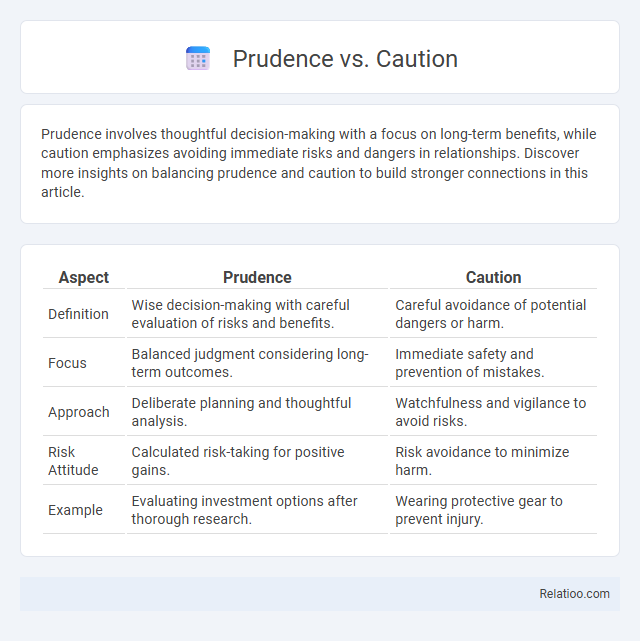Prudence involves thoughtful decision-making with a focus on long-term benefits, while caution emphasizes avoiding immediate risks and dangers in relationships. Discover more insights on balancing prudence and caution to build stronger connections in this article.
Table of Comparison
| Aspect | Prudence | Caution |
|---|---|---|
| Definition | Wise decision-making with careful evaluation of risks and benefits. | Careful avoidance of potential dangers or harm. |
| Focus | Balanced judgment considering long-term outcomes. | Immediate safety and prevention of mistakes. |
| Approach | Deliberate planning and thoughtful analysis. | Watchfulness and vigilance to avoid risks. |
| Risk Attitude | Calculated risk-taking for positive gains. | Risk avoidance to minimize harm. |
| Example | Evaluating investment options after thorough research. | Wearing protective gear to prevent injury. |
Defining Prudence and Caution
Prudence involves making thoughtful decisions by carefully weighing potential outcomes and risks to achieve long-term benefits, emphasizing wisdom and foresight. Caution focuses on avoiding danger or mistakes through careful attention and vigilance, prioritizing immediate safety and risk minimization. Understanding the distinction between prudence and caution is essential for effective decision-making, where prudence considers strategic planning and caution ensures protective measures.
Historical Perspectives on Prudence and Caution
Historical perspectives on prudence emphasize its role as a cardinal virtue, deeply rooted in classical philosophy and medieval scholasticism, where it is seen as the intellectual ability to govern and discipline oneself through reason. Caution, historically, is approached more as a practical response to potential danger, often linked to survival instincts and legal or military strategies throughout history. While prudence involves foresight and moral judgment, caution focuses on risk avoidance and carefulness, reflecting differing but complementary approaches to decision-making in past societies.
Key Differences Between Prudence and Caution
Prudence involves wise judgment and practical decision-making, emphasizing foresight and consideration of long-term consequences, while caution primarily focuses on avoiding immediate risks and dangers through careful attention. Your approach to a situation guided by prudence assesses benefits and potential outcomes, whereas caution prioritizes safety by minimizing exposure to harm. Understanding these distinctions helps tailor your responses to balance risk management with strategic planning effectively.
Psychological Roots of Prudence and Caution
Prudence and caution share psychological roots in risk assessment and decision-making, but prudence involves a balanced judgment considering long-term consequences, while caution emphasizes avoiding immediate danger. Your ability to exercise prudence depends on cognitive processes like foresight, emotional regulation, and experience, which influence how risks are weighed and choices are made. Understanding these mental mechanisms helps in applying the right level of cautious behavior without undermining proactive decision-making.
Prudence in Decision-Making
Prudence in decision-making involves carefully weighing potential risks and benefits to make informed and balanced choices that align with long-term goals. Unlike caution, which primarily focuses on avoiding danger, prudence incorporates foresight, wisdom, and ethical considerations to optimize outcomes. By applying prudence, you enhance your ability to navigate complex situations with insight and strategic thinking, ensuring decisions promote sustainable success.
Caution in Risk Assessment
Caution in risk assessment emphasizes proactive identification and mitigation of potential hazards through systematic evaluation and preventive measures. It prioritizes minimizing uncertainties and avoiding unnecessary exposure to danger by implementing strict controls and thorough analysis of possible outcomes. Effective caution integrates real-time monitoring and adaptive strategies to ensure safety while maintaining operational efficiency.
Benefits and Drawbacks of Prudence
Prudence involves thoughtful decision-making that balances risk and reward, helping you avoid impulsive choices and potential losses. The benefits of prudence include enhanced foresight and better long-term outcomes, but its drawbacks can be hesitation and missed opportunities when excessive caution slows action. Unlike caution, which often focuses solely on avoiding danger, prudence integrates practical wisdom to weigh both risks and benefits effectively.
Advantages and Pitfalls of Caution
Caution offers the advantage of minimizing risks by encouraging thorough assessment before action, which helps prevent costly errors and ensures safety in uncertain situations. However, excessive caution can lead to missed opportunities, delayed decision-making, and stagnation, negatively impacting productivity and innovation. Balancing caution with decisiveness is essential to leverage its protective benefits without falling into the pitfalls of over-cautiousness.
Real-Life Examples: Prudence vs Caution
Prudence involves careful judgment and wise decision-making based on experience and foresight, such as a financial advisor recommending diversified investments to manage risk over time. Caution, on the other hand, emphasizes immediate risk avoidance, like a pedestrian waiting for the stop signal before crossing a busy street to prevent accidents. Real-life examples highlight prudence as long-term strategic thinking, while caution centers on short-term safety measures.
Choosing the Right Approach: When to Be Prudent or Cautious
Prudence involves wise decision-making based on foresight and experience, suitable for long-term planning and assessing risks holistically. Caution emphasizes carefulness and vigilance to avoid immediate dangers, ideal in uncertain or high-risk situations requiring immediate attention. Choosing the right approach depends on context: apply prudence for strategic, reflective choices, and caution when quick, preventive actions are necessary to mitigate potential harm.

Infographic: Prudence vs Caution
 relatioo.com
relatioo.com